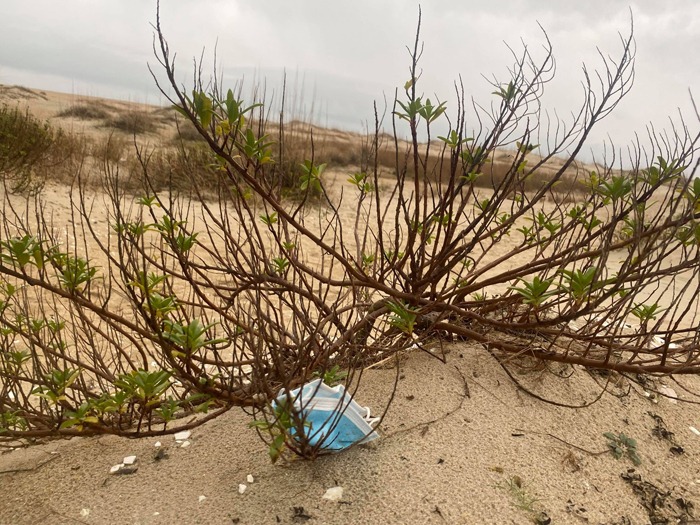
Professional beachcomber and columnist, Kristin Hissong, was heading back to her car after a long patrol on one of her favorite Hatteras Island beaches for shelling. It was a cold and windy day, and she was already a little irked by the big 7:00 a.m. crowd that had also flocked to the same beach in search of shell and seaglass finds. (Normally, crowded beaches are an unusual phenomenon in February, but not so much this year.) She was carrying a backpack full of trash, with just a couple of shells mixed in, which was also becoming a familiar but tiresome routine.
So when she approached her car and looked down, what she noticed in the gravelly parking lot was a nasty little cherry on top of an already vexing day.
It was a tampon, and it had been recently used.
“Of course I picked it up,” she says. “It was literally beside my car, and as soon as I saw it, I was worried someone was going to think it was mine… Also, I had extra plastic bags and hand sanitizer, so I grabbed it with a bunch of plastic bags [over my hand] and drove to the nearest dumpster as fast as I could. Then I sanitized my hands about 12 more times…”
“And that’s not even the weirdest or the grossest thing I’ve had to pick up this year,” she says with a laugh. “Just the most recent.”
Kristin’s business is beachcombing. An artist and a writer, she has spent more than 20,000 hours walking along Eastern Seaboard shorelines, (particularly the Outer Banks), and her treasures and ensuing stories regularly pop up in her work.
But in the past few weeks, her excursions have resulted in much more trash than treasure.
Kristin says that this past winter has been especially bad when it comes to garbage on the beach, and it’s a trend that a number of lifelong and / or local beachcombers have noticed as well.
It’s not so much that there’s more accumulation of trash on the beaches, (although that’s certainly a factor), it’s that the trash that is piling up is being ignored, and it’s being ignored by a lot of beachgoers.
“I would say that 13 days out of 14, there are multiple sets of footprints next to trash washed up on the beaches,” says Kristin. “Usually when I’m on the beach, I see people with two bags – one for trash and one for shells. But this year, that’s been happening a lot less.”
The influx of wintertime crowds on the beach is fairly easy to explain. With the rise of the Coronavirus pandemic in the past year, the Outer Banks has experienced a year-long surge in tourism due to its inherent isolation, and the ability for visitors to work from home and attend school remotely, allowing for more frequent and longer vacations. In addition, in the past few years, a number of social media and online groups dedicated to shells and seaglass have popped up, leading to a big boost in the popularity of beachcombing in general.
But the increase in trash – or the increase in people who overlook trash on a beach stroll – is a little bit harder to decipher. “I’m not sure why people aren’t picking up trash like they used to,” says Kristin. “I’ve noticed the amount of newcomers to the beach, and specifically to the beachcombing scene, so maybe they don’t know the local beach [etiquette rules]… Maybe it’s because they’re on vacation, or they’re just watching the ocean and don’t notice the litter, or they just want to enjoy their walk… I get it, regardless.”
It’s not just new visitors, either. Kristin regularly encounters the same crew of beachcombers on some of the more shelly shorelines, and a substantial proportion of these folks are leaving the washed-up trash alone. (Hang in there and keep reading, because by the end of this blog, we’re gonna name names.)
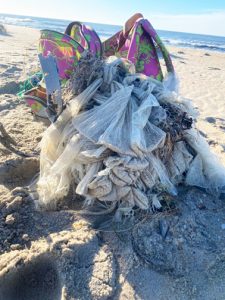
“Whatever the reasons, it’s hurtful… A lot of beachcombers I know have a connection to the ocean,” she says. “When we’re sad or angry, we go to the ocean to feel better. But to see the ocean coughing up trash and no one noticing… it hurts my feelings, and I feel deflated.”
Kristin reports that over the past weekend alone, she and her partner picked up more than six garbage bags full of trash on their favorite Buxton and Frisco stretch. It’s a routine that has certainly become more arduous – and heavy – in recent weeks, but it’s also a routine that she has been keeping up with for years.
“It’s not what we go out there to do. No one wants to go to the beach every day to pick up garbage,” she says. “But it has to be done.”
And if you ask her about the weirdest finds she’s lugged back to the dumpsters, she’ll regale you with a long list that will leave you laughing, disgusted, and utterly confused.
She has found and disposed of a toilet, a coffee machine, countless sunglasses and shoes, a gallon jug of warm mayonnaise, a condom wrapper from Jamaica that read “ONE LOVE,” multiple toothbrushes, (and dental floss), and a big, sparkly-pink… um… personal massager.
“I had so many questions about that one, because it was way up near the dune line,” she says. “Who goes to a sandy beach to, well, [have a good time?]”
Granted, it is no one’s responsibility to pick up garbage when they go to the beach, and there are plenty of people who do pick up trash when they see it, as well as lots of initiatives to keep the beaches as clean as possible.
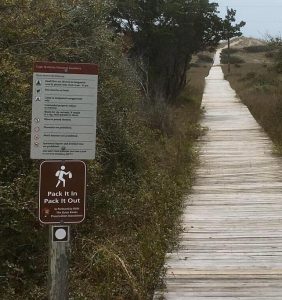
The Cape Hatteras National Seashore has dumpsters and bins stationed next to veritably every beach access point, while local organizations, (like the North Carolina Beach Buggy Association), do their part to host big beach clean-ups and public campaigns. A prominent example of this island-wide effort is the Outer Banks Preservation Association’s fairly recent “Pack it In, Pack it Out” program, which encourages visitors to take out whatever they take to the beach via signs, stickers, and good old fashioned word-of-mouth marketing.
But cleaning up your own stretch of sand is arguably an easier endeavor than cleaning up after everyone else, and unfortunately, the trash that gets left behind can have lots of long-term consequences.
Lou Browning of Hatteras Island Wildlife Rehabilitation has roughly 18 years of experience providing emergency and long-term treatment for wild animals who find themselves in trouble on the Outer Banks, and trash can play a big role in the animals who land in his care.
Years ago, the Island Free Press did a story on stray ropes, lines, nets, and other string-like pieces of trash that can find their way from the island landscape to the nests of ospreys and other birds, and can cause entanglements for both the parents, and their offspring.
“All the entanglement-type issues are still a problem,” says Lou, but he also notes that stringy materials aren’t the only unnatural beach items that can cause widespread harm to local wildlife.
“There are several problems with man-made trash on the beach. The first category is entanglement, but the second category is small pieces of plastic…. The parents mistake that as food for some reason, and when they are feeding their chicks, quite often, they are feeding them little pieces of plastic.”
The plastic pieces are unable to be digested or passed, and because they do not break down in the stomach acid, they leak out chemicals and / or become a blockage in an animal’s digestive tract.
The presence of plastic is a broader problem, too, that ties directly into the food chain. As oysters, scallops, clams, and other mollusks digest microscopic bits of plastic, they are in turn eaten by other animals, and the same digestive and internal chemical issues occur.
“It keeps adding up and getting worse as you go,” says Lou. “People aren’t going to pick up the microscopic stuff off the beach with a magnifying glass, of course, but those little pieces started out as big pieces of plastic.”
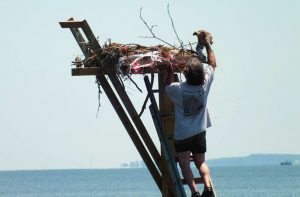
Plastic bottles and caps break down in the sun and disintegrate into pieces. Shards of rope or nets become fragmented and deteriorate over time. Cigarette filters – which are made out of plastic – can also easily be scooped up by hungry, non-human beachgoers.
“The big takeaway is that any manmade junk you can pick up and get off the beach is a plus,” says Lou. “The big pieces eventually break down into smaller pieces.”
This advice certainly applies to our beaches, but it also applies to the greater island landscape. Simply put, trash is an expansive problem that can range from the bits of plastic on the beach to cans, food containers, or disposable masks in a parking lot that attracts the attention of other island residents, such as raccoons and opossums.
And there is no easy catch-all solution to rid the island of all this unwanted debris.
“It’s a sad situation, and I don’t know the answer except to act individually, and do your part to do better,” says Lou.
Conduct a Google image search for “plastic pollution in birds” or even “plastic pollution in oceans” and you’ll be bombarded with some pretty graphic and disheartening images. There’s even a “plastic continent” that exists in the world now, situated between California and Hawaii and known as the “Great Pacific Garbage Patch,” which is three times the size of France, and which boasts 1.8 billion pieces of floating plastic that kills thousands of marine animals every year.
But despite the dismal global pollution problem, which can be too big to reasonably fathom, and a definitive increase in garbage that’s ignored close to home, Kristin Hissong stays optimistic by turning her attention to the exceptions, and to the future.
Kristin sometimes gets weird looks when she’s wandering down the beach with armfuls of big pieces of trash. “Some people, when they see me hauling garbage, they’re very standoffish…. Like I’m going to contaminate them.” She even notes that she has been mistaken as homeless before.
But it’s the brighter chance encounters that keep her positive mindset going.
Just days before she stumbled upon the used tampon, Kristin encountered a pair of ladies from Massachusetts who noticed her undesirable and trash-infused haul, and who stopped her to thank her for picking up litter during a beach stroll.
“They said it was so refreshing to see someone else picking up garbage, because the whole time they were here they hadn’t seen it, and they were picking up garbage at every beach stop,” she says. “To have a random stranger appreciate it, and to get confirmation that they are picking up garbage that they see as well – that gives me hope.”
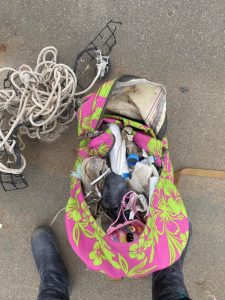
Kristin is also optimistic about the next generation of beachcombers. She has taken a number of children and families out on beachcombing excursions, and she attests that it’s the youngest members of a group who do the heavy lifting.
“When I go beachcombing with children, it’s a breath of fresh air to see them enthusiastically picking up garbage,” she says. “They seem to pick up trash more, and they are proud that they are able to collect so much.”
“Of course, they don’t have to bend down as much, because they are closer to the ground,” she adds with a laugh.
So why don’t the adults and other beachgoers pick up litter with as much enthusiasm? As stated earlier, Kristin has a few theories, but her most prominent one is that it’s simply because no one else is picking up trash, either.
“I believe that they see all the other footprints next to a piece of trash and think, ‘I’m not the first one to walk past that, so it’s ok if I keep going; it’s not my responsibility,’” she says. “That’s a big reason, I think.”
“Beachcombing has increased in popularity, and it has also increased some people’s competitive nature,” she adds. “Some people are so focused on finding the treasures, and being the first ones there, that they skip over the trash.”
Kristin is much too gracious to give the specific names of the competitive and inconsiderate beachcombers who skip past the litter to get the good stuff. But I have a lot less class, and know at least one person who perfectly fits this description, (and who she surely has in mind), who I will name right now…
It’s me.
For many years, Kristin and I have shared the same popular shelling beaches, and I tag along with her whenever I can, (while trying not to be too obnoxious), because Kristin isn’t just a fountain of knowledge – she is a geyser.
It’s because of Kristin that I know what outside factors change the color of shells, or what creates crystalized whelks, or what fossilized whale vomit looks like. (It’s actually quite beautiful!)
In our first few beach encounters, we would chat, and she would pick up trash, while I paused and watched her pick up trash.
After a while, I’d pick it up too, but mostly because she was watching, and I didn’t want to look like a litter-ignoring jerk, (which I was.)
Slowly, it became a habit of my own, and especially after years of stories, interviews, and pictures that made it evident just how damaging it could be to leave that litter behind on the sand. (The aforementioned Lou Browning story was definitely a wake-up call, while the “Pack it in, Pack it out” story was an inspiration.)
Today, I’m happy to admit that I pick up trash regularly without Kristin’s supervision, or without anyone else on the beach to “impress.” Once you form the habit, it’s hard to break, and while I don’t always have enough room in my old beach bag to grab every single piece, (and there’s always a lot of debris after a storm), I try to tell myself that I’m doing my best.
And as Kristin has noticed multiple times, (and which I can verify after finding a perfect helmet shell buried under a plastic bag), there can be some tangible and instant rewards for picking up trash, too.
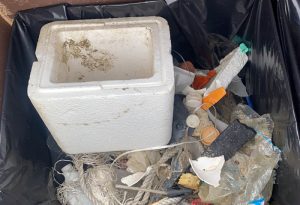
“I always seem to find my best treasures under trash,” she says. “90% of the time, if I pick up a piece of trash, there’s a treasure underneath, and especially on popular beaches… Once, I picked up a piece of Styrofoam as big as a plate, and underneath it was a dark red piece of seaglass one inch away from me, in a shell pile that everyone else had rooted through.”
“I hear those types of stories from lots of beachcombers I share trash stories with. It’s like the ocean is saying ‘thank you.’”
Kristin emphasizes that you don’t have to pick up every single piece of debris on every beach trip, and that no one should be raked against the coals for ignoring those random pieces of litter that tend to wash up with the ocean-produced treasures.
“No one wants to be told that they suck by not picking up trash, and no one does suck… sometimes you don’t see it, sometimes you’re focused on something else, and sometimes you’re in a bad mood and just want to focus on the good things,” she says.
She doesn’t judge the folks who walk past the trash. But she does treasure the folks who try to keep the beaches clean. The ladies she met from Massachusetts – the ones who were so dedicated to picking up litter on every beach trip – is her favorite memory so far of this past winter season of beachcombing, and after their conversation, she somehow ended up giving them the lone Scotch Bonnet she had found that day, and the only perfect Scotch Bonnet she had found in weeks.
“At the end of the day, we all want to live in a beautiful world, and just because you don’t pick up trash now doesn’t mean you that can’t start,” she says. “But if you’re a beachcomber, you’re missing out if you don’t pick up that trash that everyone else left behind, because I guarantee you’ll find more treasure if you pick up trash…”
“And if not, you can just call me, and I’ll give you some,” she adds. “I’ll be happy to share my treasure as a ‘Thank You’ for helping to keep our beaches clean.”




Sweet & Caring & Funny Article!
Yes….. finding Treasures ‘under junk & Trash’ is Too Cool!
Is The Only way I find Scotch Bonnets now!!
I live in Avon; call me when ‘you need a helper/trash-picker-upper’!
Again Great Post to Joy & Kristin too!!!
Love, Carol & Bo Wallis